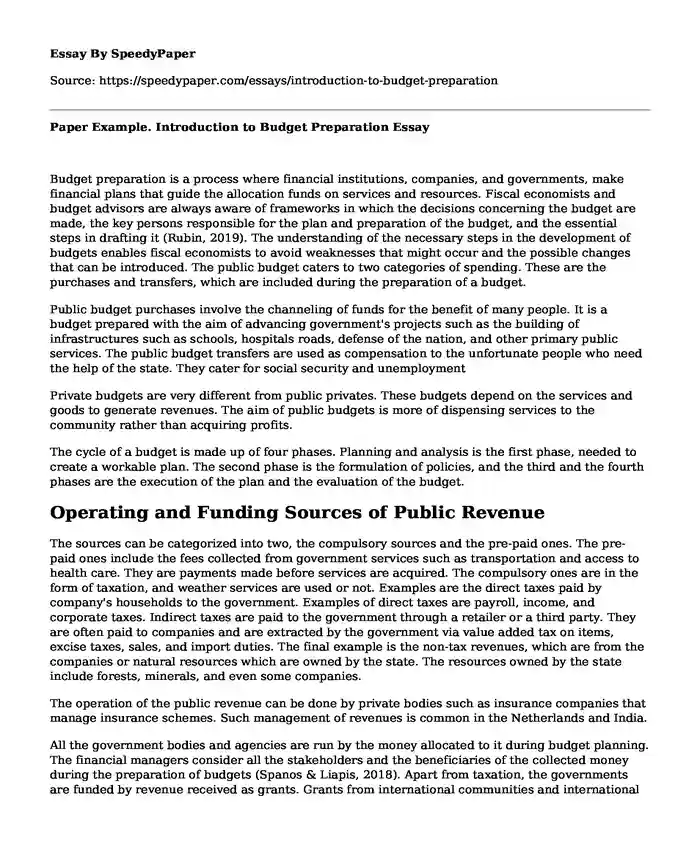
| Type of paper: | Business plan |
| Categories: | Company Government Budgeting Accounting |
| Pages: | 3 |
| Wordcount: | 802 words |
Budget preparation is a process where financial institutions, companies, and governments, make financial plans that guide the allocation funds on services and resources. Fiscal economists and budget advisors are always aware of frameworks in which the decisions concerning the budget are made, the key persons responsible for the plan and preparation of the budget, and the essential steps in drafting it (Rubin, 2019). The understanding of the necessary steps in the development of budgets enables fiscal economists to avoid weaknesses that might occur and the possible changes that can be introduced. The public budget caters to two categories of spending. These are the purchases and transfers, which are included during the preparation of a budget.
Public budget purchases involve the channeling of funds for the benefit of many people. It is a budget prepared with the aim of advancing government's projects such as the building of infrastructures such as schools, hospitals roads, defense of the nation, and other primary public services. The public budget transfers are used as compensation to the unfortunate people who need the help of the state. They cater for social security and unemployment
Private budgets are very different from public privates. These budgets depend on the services and goods to generate revenues. The aim of public budgets is more of dispensing services to the community rather than acquiring profits.
The cycle of a budget is made up of four phases. Planning and analysis is the first phase, needed to create a workable plan. The second phase is the formulation of policies, and the third and the fourth phases are the execution of the plan and the evaluation of the budget.
Operating and Funding Sources of Public Revenue
The sources can be categorized into two, the compulsory sources and the pre-paid ones. The pre-paid ones include the fees collected from government services such as transportation and access to health care. They are payments made before services are acquired. The compulsory ones are in the form of taxation, and weather services are used or not. Examples are the direct taxes paid by company's households to the government. Examples of direct taxes are payroll, income, and corporate taxes. Indirect taxes are paid to the government through a retailer or a third party. They are often paid to companies and are extracted by the government via value added tax on items, excise taxes, sales, and import duties. The final example is the non-tax revenues, which are from the companies or natural resources which are owned by the state. The resources owned by the state include forests, minerals, and even some companies.
The operation of the public revenue can be done by private bodies such as insurance companies that manage insurance schemes. Such management of revenues is common in the Netherlands and India.
All the government bodies and agencies are run by the money allocated to it during budget planning. The financial managers consider all the stakeholders and the beneficiaries of the collected money during the preparation of budgets (Spanos & Liapis, 2018). Apart from taxation, the governments are funded by revenue received as grants. Grants from international communities and international banks are useful in starting income-generating activities in communities. There should be a constant review of past budgets to predict the future and draft a comprehensive one for the upcoming year.
Effects of Demographics on public Revenue Services
Demographics mainly affect public revenue services. For any budget planning to be effective and useful in a society, the financial dockets need to consider the demographic records. Demographics is defined as the study of a population. It involves Factors such as age, income, and social status, death, and birth rates in a community affect how the government distributes resources.
An instance is that in a community where unemployment is rampant, there is a possibility of little taxes to be collected. Once these effects are identified, the government can make an effort to maximize the revenue collected either by imposing taxes on vehicle registration, introducing import and export tariffs, and even introducing road usage tolls. It influences the way human labor is sourced for various tasks. Finally, the demographics affect the way the collected taxes are re-distributed back to society for development. Densely populated societies will have different needs from those in sparsely populated ones.
Conclusion
In conclusion, private budgets belong to companies and organizations which aim at making profits. Public budgets are the government's initiative to introduce services to citizens in various communities. Public budgeting is complicated and needs planning. It is affected by demographic factors since it is funded by taxes collected from citizens, both employed and unemployed.
References
Rubin, I. S. (2019). The politics of public budgeting: Getting and spending, borrowing, and balancing. CQ Press.
Spanos, P., & Liapis, K. (2018). International Accounting Standards, Budgeting and Controlling in Private and Public Sector. KnE Social Sciences, 107-130.
Cite this page
Paper Example. Introduction to Budget Preparation. (2023, Apr 05). Retrieved from https://speedypaper.net/essays/introduction-to-budget-preparation
Request Removal
If you are the original author of this essay and no longer wish to have it published on the SpeedyPaper website, please click below to request its removal:
- Essay Sample on Launching Pharmaceutical in Latin America
- Free Essay Example on Information Technology in Healthcare
- Free Essay Example about Family Unit
- Free Essay Example on Visual Culture
- Essay Sample Analyzing the Ethical Violation Cases
- Space Essay Example for Free Use
- Essay Example About Causes of Birth Defects
Popular categories




